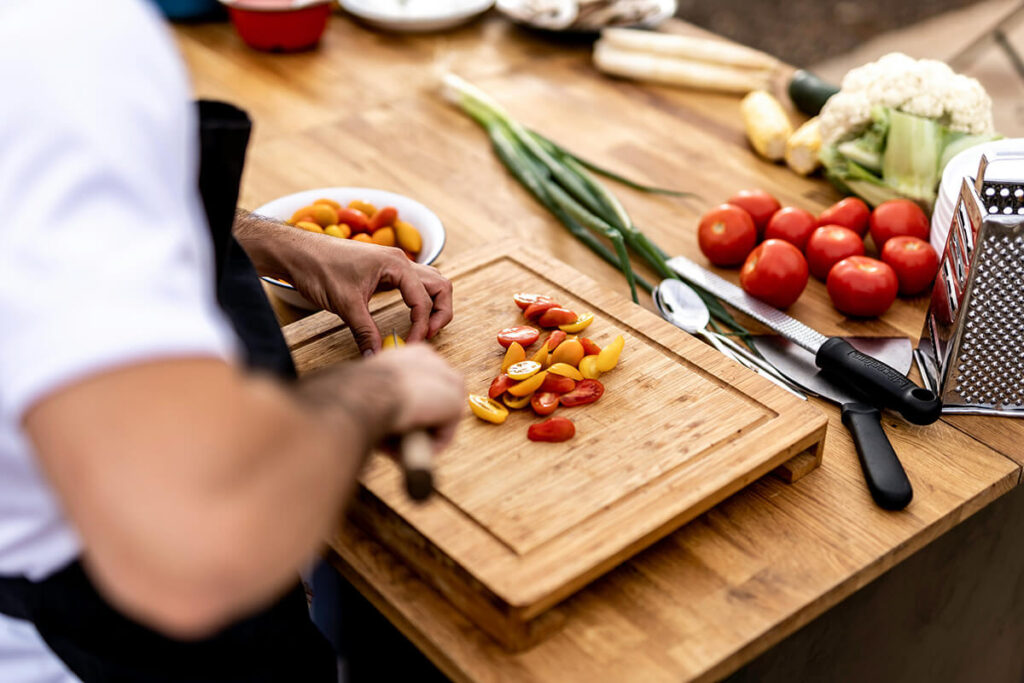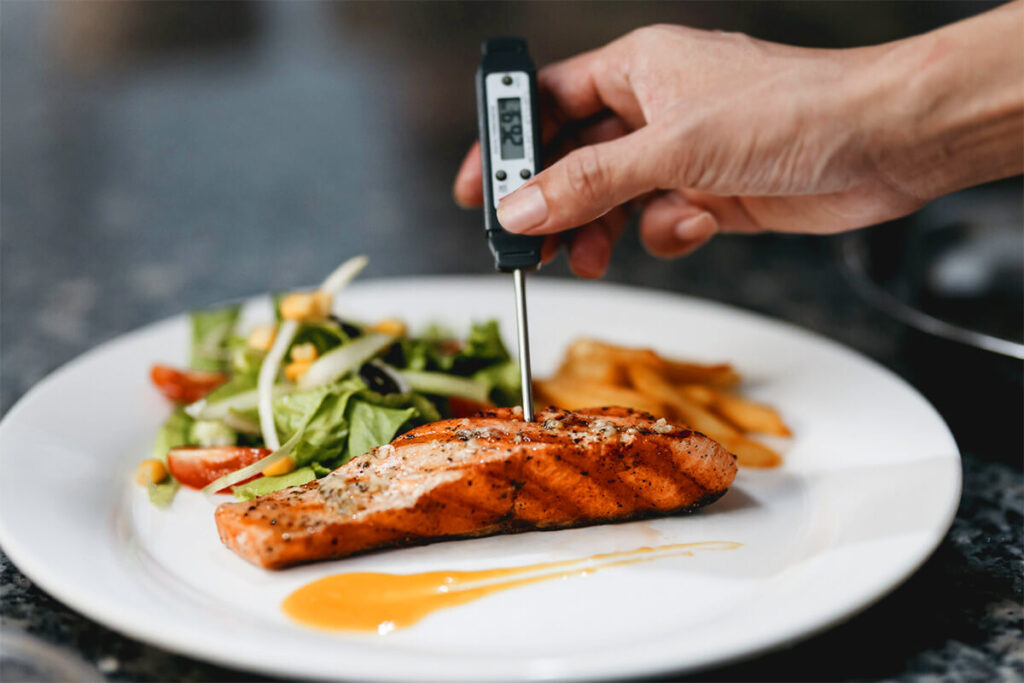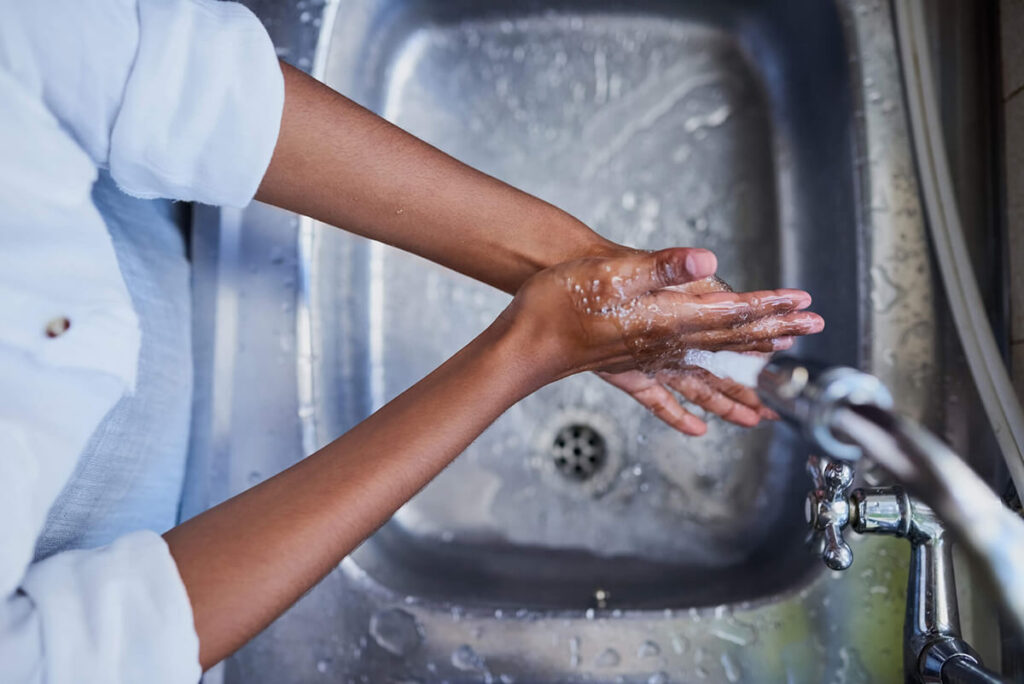Your guide to safe food handling
In hospitality, where every dish tells a story and each guest’s experience is carefully crafted, safe food handling is vital. If you’re wondering how to manage this effectively, this guide is for you!
You’ll discover various safe food handling methods, ways to conduct employee evaluations, examples of best practices with tools like personal protection equipment, and more.

Why safe food handling matters
It protects your customers
Safe food handling practices are essential for protecting your customers from foodborne illnesses. Proper food handling techniques can minimize the risk of contamination and ensure the safety of the food served in your establishment.
For example, improper handling of raw meat can lead to cross-contamination, resulting in foodborne illnesses such as Salmonella or E. coli. By following safe food handling practices, you can prevent such incidents and protect the health of your patrons.

Preserves your reputation
A single foodborne illness outbreak can tarnish your reputation and drive away customers. One impactful way to prevent this is by sticking to safe food handling practices in your venue.
When you show your customers that you take safe food handling practices seriously, you show a commitment to providing a safe and enjoyable dining experience. This can help build trust and loyalty among your customers, and as we all know, a positive reputation amongst patrons is fundamental for long-term success.
How to manage safe food handling effectively
Training and employee evaluation
Proper training and education are essential to ensure all staff members understand and follow safe food handling practices. Provide comprehensive training on topics such as:
- proper handwashing techniques
- temperature control
- the importance of personal protection equipment, and
- cross-contamination prevention.
Run regular training sessions and quizzes to reinforce knowledge and ensure compliance with food safety regulations. It also gives you a great opportunity to do some employee evaluation. Praise your staff members’ wins and discuss where they can improve.
Training can be tricky in a busy environment like a restaurant; that’s why Operandio’s digital training and quiz mobile-first platform is a game-changer. With it you can provide engaging and effective training directly to your frontline workforce on any device, anytime, anywhere.

Temperature control
Maintaining proper temperature control is crucial for preventing the growth of harmful bacteria in food. Train your staff on the importance of storing and cooking food at the correct temperatures to ensure its safety.
Provide examples of safe storage temperatures for perishable items such as meat, poultry, and dairy products. For instance, raw meat should be stored at temperatures below 40°F (4°C) to prevent bacterial growth.
Install digital temperature monitoring systems and establish procedures for checking and recording food temperatures regularly. This is much easier than you might think. Our article, ‘Improving kitchen temperature monitoring systems’, can enhance your understanding of the topic.
Cross-contamination prevention
Cross-contamination occurs when harmful bacteria from raw or contaminated food are transferred to ready-to-eat foods, posing a significant risk to consumers. Implement strategies to prevent cross-contamination in your kitchen.
Implement strategies that minimize risk, such as segregating raw and cooked foods to prevent the spread of harmful bacteria. For instance, designate separate cutting boards and utensils for raw meats and ready-to-eat foods.
After a decent amount of time, like every two months, make sure you conduct an employee evaluation. As we’re all human, we forget things. Doing this review can help spot issues and offer a chance for you and your staff to correct them.

Hygienic food preparation
Regular handwashing
- Hands should be washed with soap and water for at least 20 seconds before and after handling food, after using the restroom, and after touching surfaces that may be contaminated.
- Provide easy access to handwashing stations equipped with soap, water, and disposable towels. To reinforce the message, consider posting reminders about hand hygiene in prominent areas of the kitchen.
Clean uniforms and personal hygiene
- Uniforms should be cleaned when they get dirty with detergent at high temperatures of 140° F (60° C) to kill bacteria. Even if they remain unsoiled, give them a wash every week for the sake of cleanliness.
- Enforce rules that specify how hair should be covered or tied back and what jewelery is allowed/not allowed depending on the employee’s role, as this could pose a contamination risk.
- Consider having a policy that prohibits staff from wearing artificial nails, which can harbor bacteria. Plus, nobody wants an acrylic nail in their lobster bisque.
Use of personal protection equipment
- Disposable gloves are essential when handling ready-to-eat foods such as salads or sandwiches to prevent contamination. They should be changed after every single use, especially after handling raw foods or touching surfaces that may be contaminated.
- Teach the correct way to put on, remove, and dispose of gloves to minimize the risk of cross-contamination. Remind them that gloves are not a substitute for proper handwashing and should be used alongside hand hygiene practices.
- This also gives you a chance to do some employee evaluation and review how they use personal protection equipment and correct them if necessary.
Proper cleaning and sanitizing procedures
- Establish a cleaning schedule that includes regular cleaning and sanitizing of any food contact surfaces, equipment, and utensils.
- Use cleaning products that are approved for use in food service establishments and follow manufacturer instructions for dilution and contact time.
- Designate specific cleaning tasks for staff members and ensure they understand the importance of thorough cleaning and sanitizing practices.
- To prevent cross-contamination, consider implementing a color-coded system for cleaning cloths and utensils.
By implementing these tactics, you can create a safer and more hygienic environment for both your staff and patrons, guaranteeing a positive dining experience for everyone.
Operandio streamlines safe food handling
Operandio offers cutting-edge solutions to streamline staff training, simplify temperature monitoring, and prevent cross-contamination. Expand on your venue’s commitment to food safety by booking a free demo with Operandio today.


